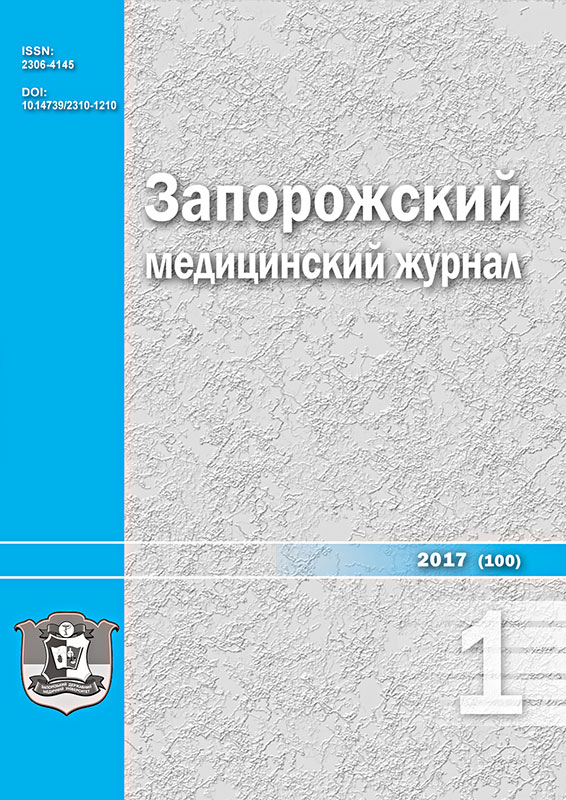Content and balance of trace elements in placenta on different stages of gestation
DOI:
https://doi.org/10.14739/2310-1210.2017.1.91708Keywords:
trace elements, prematurity, placenta, fetusAbstract
Functional status of placenta, which provides nutrients to the fetus, plays an important role in miscarriage.
The aim to investigate content and balance of trace elements (Fe, Cu, Co, Zn, Mg, Mn) in placenta in different terms of gestation.
Materials and methods. We studied content and balance of essential trace elements (Fe, Cu, Co, Zn, Mg, Mn) in placenta of 52 women which born babies in different terms of gestation. The content of micronutrients studied using atomic absorption spectrophotometer C-115 MI.
Results. We established average content and ratio of essential trace elements in placenta of women which born babies on 24-28, 29-31, 32-36 and 37-41 week of gestation.
Conclusions. Intensive processes of accumulation and transport of essential trace elements took place in placenta during gestation. It was noted that the content of Fe, Cu and Zn was increased during gestation process and reached maximum level on 29-31 week of gestation. Mn content reached maximum level on 32-36 weeks. Indicators of Co in placenta gradually increased from 24-28 week of gestation and Mg level by contrast reduced. In addition, we investigated the ratio of essential trace elements in placenta, which showed that in pairs Fe/Co, Cu/Co, Zn/Mn and Mg/Mn we observed a significant decreasing of indicators (p<0.05) from 24 to 36 week of gestation, and in pairs Fe/Mg, Cu/Zn, Cu/Mg and Co/Mg - significant increasing of indicators during gestational process. Also we found a positive correlation between Cu and Mn (rxy=0.5732, p<0.05) at 24-28 weeks of gestation, Mg and Mn (rxy=0.5855, p<0.05) on 32-36 weeks, Mg and Mn on 29-31 weeks (rxy=0.8272, p<0.01) and Zn and Mn on 32-36 week of gestation (rxy=0.8097, p<0.05). So, features of transport and deposition of essential trace elements require further research.
References
Blencowe, H., Cousens, S., Oestergaard, M. Z., Chou, D., Moller, A. B., Narwal, R. et al. (2012). National, regional, and worldwide estimates of preterm birth rates in the year 2010 with time trends since 1990 for selected countries: a systematic analysis and implications. Lancet, 379(9832), 2162–2172. http://dx.doi.org/10.1016/S0140-6736(12)60820-4.
Allanson, E. R., Vogel, J. P., Tunçalp, Ӧ., Gardosi, J., Pattinson, R. C., Francis, A. et al. (2016). Application of ICD-PM to preterm-related neonatal deaths in the UK and South Africa. BLOG, 123(12), 2029–2036. doi: 10.1111/1471-0528.14245.
Morgan, T. K., Tolosa, J. E., Mele, L., Wapner, R. J., Spong, C. Y., Sorokin, Y. et al. (2013). Placental villous hypermaturation is associated with idiopathic preterm birth. The Journal of Maternal-Fetal & Neonatal Medicine, 26(7), 647–653. doi: 10.3109/14767058.2012.746297.
Izquierdo Alvarez, S., Castañón, S. G., Ruata, M. L., Aragüés, E. F., Terraz, P. B., Irazabal, Y. G. et al. (2007). Updating of normal levels of copper, zinc and selenium in serum of pregnant women The Journal of Trace Elements in Medicine and Biology, 21(1), 49–52. doi: 10.1016/j.jtemb.2007.09.023.
Collard, K. J. (2009). Iron homeostasis in the neonate. Pediatrics, 123(4), 1208–1216. doi: 10.1542/peds.2008-1047.
Ohata, Y., Ozono, K., & Michigami, T. (2016). Current concepts in perinatal mineral metabolism. Clin Pediatr Endocrinol, 25(1), 9–17. doi: 10.1297/cpe.25.9.
Wulf, K., Wilhelm, A., Spielmann, M., Wirth, S., & Jenke, A. C. (2013). Frequency of Symptomatic Zinc Deficiency in very Low Birth Weight Infants. Klin Padiatr, 225(1), 13–17. doi: 10.1055/s-0032-1312610.
Yoon, M., Schroeter, J. D., Nong, A., Taylor, M. D., Dorman, D. C., Andersen, M. E. et al. (2011). Physiologically based pharmacokinetic modeling of fetal and neonatal manganese exposure in humans: describing manganese homeostasis during development. Toxicol Sci, 122(2), 297–316. doi: 10.1093/toxsci/kfr141.
Eum, J. H., Cheong, H. K., Ha, E. H., Ha, M., Kim, Y., Hong, Y. C., et al. (2014). Maternal blood manganese level and birth weight: a MOCEH birth cohort study. Environ Health, 13(1), 31. doi: 10.1186/1476-069X-13-31.
Downloads
How to Cite
Issue
Section
License
Authors who publish with this journal agree to the following terms:
Authors retain copyright and grant the journal right of first publication with the work simultaneously licensed under a Creative Commons Attribution License that allows others to share the work with an acknowledgement of the work's authorship and initial publication in this journal. 

